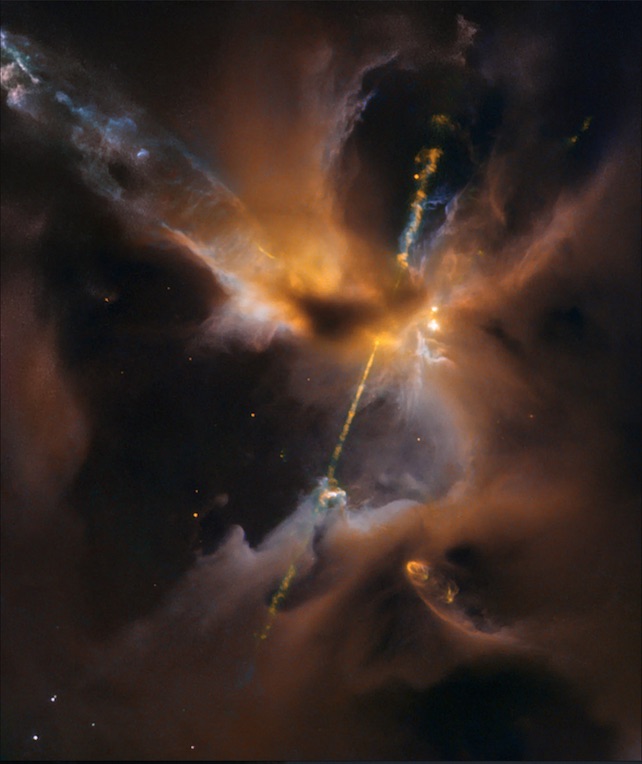Although details are sketchy, life on Earth is thought to have arisen about 4 billion years ago from a deadly mixture of organic compounds, often referred to as the “primordial soup.”
How and where the ingredients of this primitive biological entrée arose remains an area of debate, given the timeline and surface conditions that cooled the infant Earth.
As recent research shows, important substances such as amino acids, lipids and sugars can form deep in space and have been Teleported to early Earth Through meteorites and comets.
According to a new study by a German and French team, this scenario is not only plausible, but provides the most likely explanation for how Earth acquired some of the building blocks of life, some of which could have formed more efficiently in interstellar space.
The study focused specifically on the formation of peptides, or short chains of 2 to 50 amino acids linked by chemical links called peptide bonds.
Peptides are the key to life on Earth. They are composed of unique amino acid sequences and have a variety of functions, such as catalyzing a range of biological processes. The authors note that ancient peptides may also have played a role in the formation of primitive precursors to cell membranes.
The researchers added that despite the obvious importance of peptides for the existence of life on Earth, the young planet may not have provided a favorable environment for their formation.
They explain that water may have a confounding effect on the chemical composition to form peptides, and therefore may hinder this part of natural occurrence, or the emergence of life in nonliving materials.
Surprisingly, there’s a kinder place for peptides to form: the interstellar medium, a term that refers to the sparse material and radiation that occupies the vast space between star systems.
Led by astrophysicist Serge Krasnokutski of the Max Planck Institute for Astronomy in Germany, the study’s authors simulated conditions in the interstellar medium, allowing them to perform experiments in the laboratory to test some key details about how our planet ended up producing peptides.
For example, they demonstrated that the synthesis of peptides depends on three chemical components: carbon, carbon monoxide, and ammonia, whose presence can trigger the formation of amino acid-like aminoketene molecules in low-density interstellar dust clouds.
The researchers note that when this molecular cloud condenses, its dust particles begin to condense, and the aminoketene molecules can assemble into chains, known as peptides.
The continued condensation of dust particles in interstellar space can help transform thin molecular clouds into denser protoplanetary disks, rings of debris around stars, which eventually further condense to form planets, moons and other celestial bodies.
In these circumstellar disks, comets or asteroids at large distances from stars are “the most interesting objects for peptide formation,” the researchers wrote.
When such an object approaches a star and warms, the evaporation of molecules within it is usually suppressed, leaving only molecules from the thin surface layer free to evaporate.
Once the object’s temperature rises to 176 Kelvin, the ammonia in its molecular ice combines with water to form a mixture with a melting point lower than its components. Liquefied material deep within a comet or asteroid is essentially unable to evaporate and therefore may be “very suitable” for the formation of aminoketene molecules, the study authors wrote.
They note that solid molecules can move more freely in this liquid state, allowing high concentrations of ammonia molecules to act as catalysts.
Furthermore, because rapid warming disrupts the formation of peptide bonds, the long timescales over which these objects experience temperature changes are more likely to support peptide synthesis, providing more time for the necessary chemical reactions to occur.
The authors believe that peptides likely formed in this way as our solar system developed and may have later arrived at Earth as the young planet was bombarded by meteorites, comets and other objects that may have contained peptides.
The arrival of peptides will provide the planet with at least one key ingredient of life, aiding in the development of protomembranes, or membrane precursors that give cells their structure and limit their contents.
More research is needed to explore these findings and continue to fill in the gaps in our understanding of the origins of life, but the authors say this study provides substantial support for the idea that alien ingredients helped Earth’s primordial soup turn into life.
The study was published in scientific progress.
#important #ingredients #life #formed #center #comet
Image Source : www.sciencealert.com
